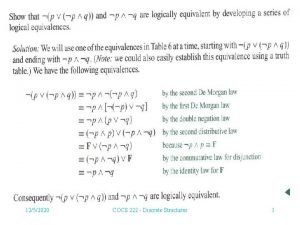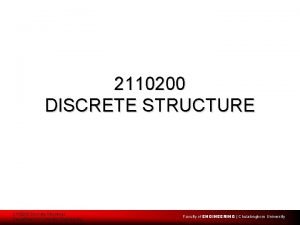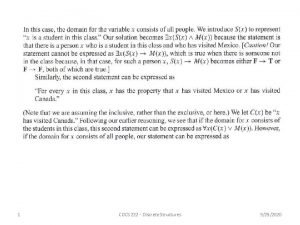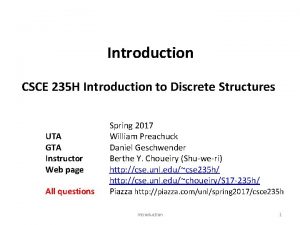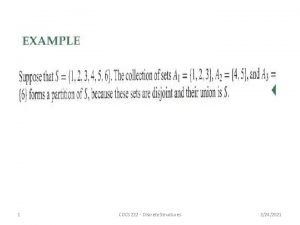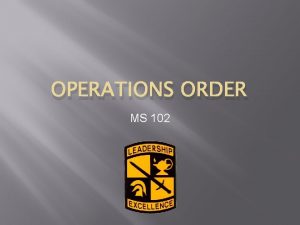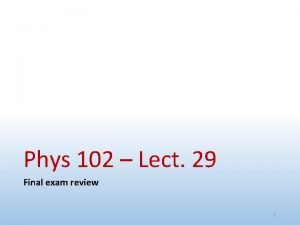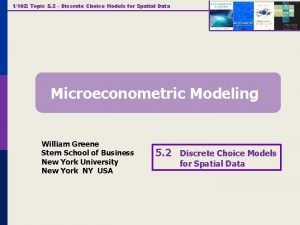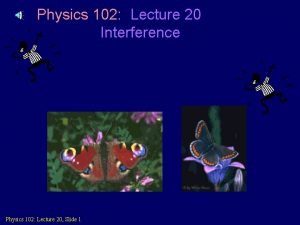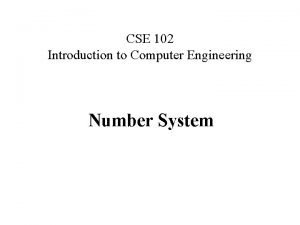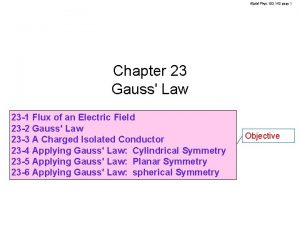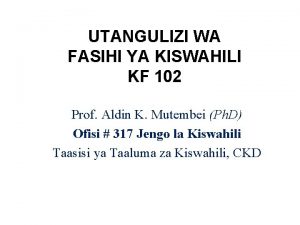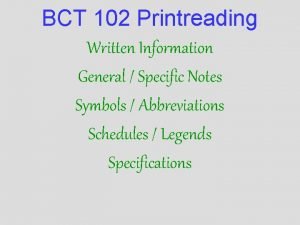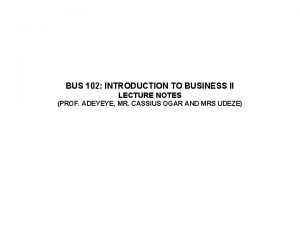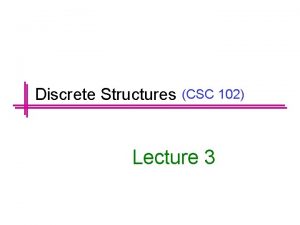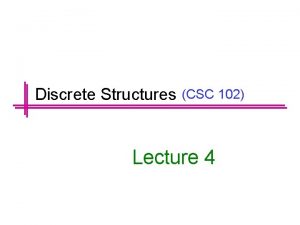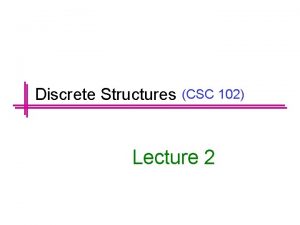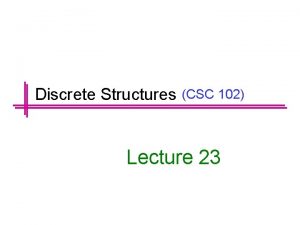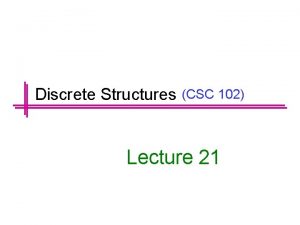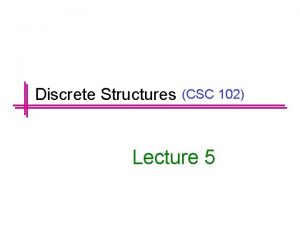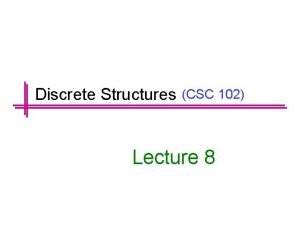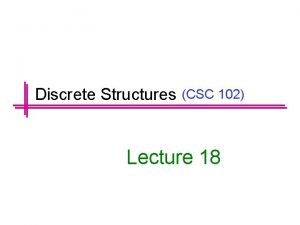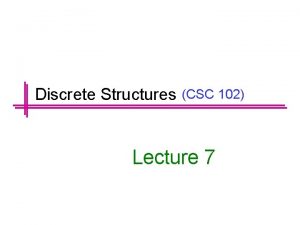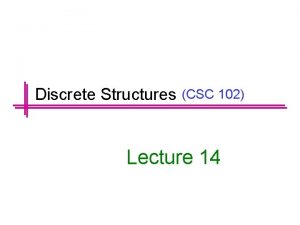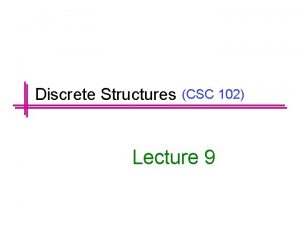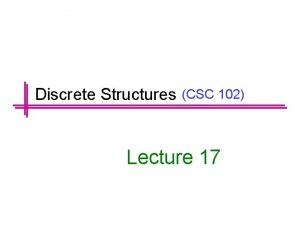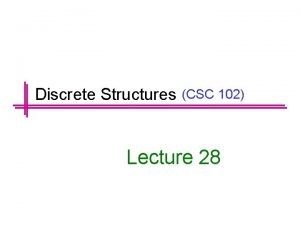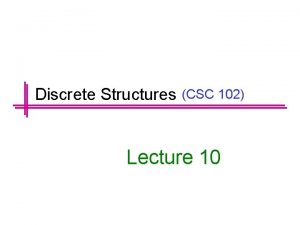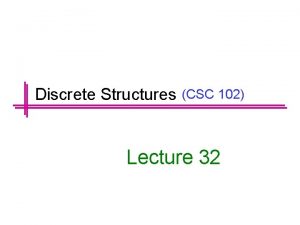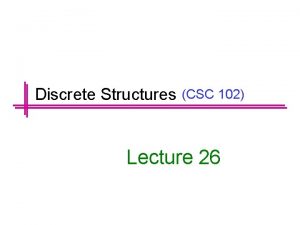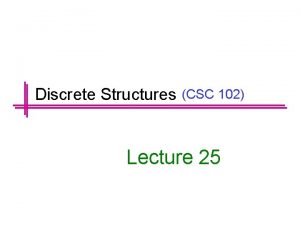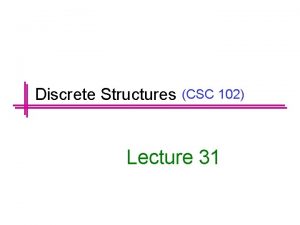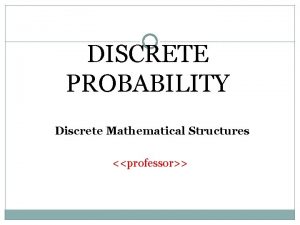Discrete Structures CSC 102 Lecture 16 Previous Lecture




































- Slides: 36

Discrete Structures (CSC 102) Lecture 16

Previous Lecture Summery v Basic concepts of relation v Types of relations v Relation on a set v The inverse of a relation v Representing relations using Digraphs v N-ary Relations

Today’s Lecture v Properties of relations v Reflexive, Symmetric and Transitive Relations v Properties of “Less than” relations v Properties of Congruence Modulo 3 v Transitive closure of a relations

Representing Relations Using Digraphs Definition A directed graph, or digraph, consists of a set V of vertices (or nodes) together with a set E of ordered pairs of elements of V called edges (or arcs). The vertex a is called the initial vertex of the edge (a, b), and the vertex b is called the terminal vertex of this edge. We can use arrows to display graphs.

Representing Relations Using Digraphs Example: Display the digraph with V = {a, b, c, d} and E = {(a, b), (a, d), (b, b), (b, d), (c, a), (c, b), (d, b)}. a d b c An edge of the form (b, b) is called a loop.

Representing Relations Using Digraphs Let A = {3, 4, 5, 6, 7, 8} and define a relation R on A as follows: For all x, y ∈ A, x R y ⇔ 2 | (x − y). Draw the directed graph of R. Note that 3 R 3 because 3 − 3 = 0 and 2 | 0 since 0 = 2 · 0. Thus there is a loop from 3 to itself. Similarly, there is a loop from 4 to itself, from 5 to itself, and so forth, since the difference of each integer with itself is 0, and 2 | 0. Note also that 3 R 5 because 3 − 5 = − 2 = 2 · (− 1). And 5 R 3 because 5 − 3 = 2 · 1. Hence there is an arrow from 3 to 5 and also an arrow from 5 to 3. The other arrows in the directed graph, are obtained by similar reasoning.

Directed Graph of a Relation Let A = {3, 4, 5, 6, 7, 8} and define a relation R on A as follows: For all x, y ∈ A, x R y ⇔ 2 | (x − y). Draw the directed graph of R.

N-ary Relations A binary relation is a subset of a Cartesian product of two sets, similarly, an n-ary relation is a subset of a Cartesian product of n sets. Definition Given sets A 1, A 2, . . . , An, an n-ary relation R on A 1 × A 2 ×· · ·× An is a subset of A 1 × A 2 ×· · ·× An. The special cases of 2 ary, 3 -ary, and 4 -ary relations are called binary, ternary, and quaternary relations, respectively. The sets A 1, A 2, …, An are called the domains of the relation, and n is called its degree.

N-ary Relations Example Let R = {(a, b, c) | a = 2 b b = 2 c with a, b, c N} What is the degree of R? The degree of R is 3, so its elements are triples. What are its domains? Its domains are all equal to the set of integers. Is (2, 4, 8) in R? No. Is (4, 2, 1) in R? Yes.

A Simple Database (Application) Example: Consider a database of students, whose records are represented as 4 -tuples with the fields Student Name, ID Number, Major, and GPA: R = {(Ackermann, 231455, CS, 3. 88), (Adams, 888323, Physics, 3. 45), (John, 102147, CS, 3. 79), (Mac, 453876, Math, 3. 45), (Rao, 678543, Math, 3. 90), (Stevens, 786576, Psych, 2. 99)} Relations that represent databases are also called tables, since they are often displayed as tables.

Properties of Relations We will now look at some useful ways to classify relations. Definition: A relation R on a set A is called reflexive, if (a, a) R for every element a A. Are the following relations on {1, 2, 3, 4} reflexive? • R = {(1, 1), (1, 2), (2, 3), (3, 3), (4, 4)} No • R = {(1, 1), (2, 2), (2, 3), (3, 3), (4, 4)} Yes • R = {(1, 1), (2, 2), (3, 3)} No A relation on a set A is not reflexive if there exist some element a A such that (a, a) R.

Properties of Relations Definitions • A relation R on a set A is called symmetric if (b, a) R whenever (a, b) R for all a, b A. • A relation R on a set A is called antisymmetric if a = b whenever (a, b) R and (b, a) R. • A relation R on a set A is called asymmetric if (a, b) R implies that (b, a) R for all a, b A.

Properties of Relations Are the following relations on {1, symmetric, antisymmetric, or asymmetric? 2, • R = {(1, 1), (1, 2), (2, 1), (3, 3), (4, 4)} Symmetric • R = {(1, 1)} Antisymmetric. • R = {(1, 3), (3, 2), (2, 1)} Asymmetric. • R = {(4, 4), (3, 3), (1, 4)} Antisymmetric. 3, 4}

Properties of Relations Definition: A relation R on a set A is called transitive if whenever (a, b) R and (b, c) R, then (a, c) R for a, b, c A. Are the following relations on {1, 2, 3, 4} transitive? • R = {(1, 1), (1, 2), (2, 1), (3, 3)} • R = {(1, 3), (3, 2), (2, 1)} • R = {(2, 4), (4, 3), (2, 3), (4, 1)} Yes No No

Properties of Relations Let A = {0, 1, 2, 3} and define relations R, S, and T on A as follows: • R = {(0, 0), (0, 1), (0, 3), (1, 0), (1, 1), (2, 2), (3, 0), (3, 3)}, • S = {(0, 0), (0, 2), (0, 3), (2, 3)}, • T = {(0, 1), (2, 3)}. a. Is R reflexive? symmetric? transitive? b. Is S reflexive? symmetric? transitive? c. Is T reflexive? symmetric? transitive?

Properties of Relations Let A = {0, 1, 2, 3} and define relations R, S, and T on A as follows: • R = {(0, 0), (0, 1), (0, 3), (1, 0), (1, 1), (2, 2), (3, 0), (3, 3)}; The directed graph of R has the appearance shown below

Properties of Relations Let A = {0, 1, 2, 3} and define relations R, S, and T on A as follows: • S = {(0, 0), (0, 2), (0, 3), (2, 3)}; The directed graph of S has the appearance shown below

Properties of Relations Let A = {0, 1, 2, 3} and define relations R, S, and T on A as follows: • T = {(0, 1), (2, 3)}. The directed graph of T has the appearance shown below

Properties of Relations How many different reflexive relations can be defined on a set A containing n elements? Solution: Relations on R are subsets of A A, which contains n 2 elements. • Therefore, different relations on A can be generated by choosing different subsets out of these n 2 elements, so there are 2 n 2 relations. • A reflexive relation, however, must contain the n elements (a, a) for every a A. • Consequently, we can only choose among n 2 – n = n(n – 1) elements to generate reflexive relations, so there are 2 n(n – 1) of them.

Properties of “Less Than” relation Define a relation R (the set of all real numbers) as follows: For all x, y ∈ R, x R y ⇔ x < y. a. Is R reflexive? b. Is R symmetric? c. Is R transitive? R is not reflexive: R is reflexive if, and only if, ∀x ∈ R, x R x. By definition of R, this means that ∀x ∈ R, x < x. But this is false: ∃x ∈ R such that x ≮ x. As a counterexample, let x = 0 and note that 0 ≮ 0. Hence R is not reflexive.

Properties of “Less Than” relation Define a relation R (the set of all real numbers) as follows: For all x, y ∈ R, x R y ⇔ x < y. a. Is R reflexive? b. Is R symmetric? c. Is R transitive? R is not symmetric: R is symmetric if, and only if, ∀x, y ∈ R, if x R y then y R x. By definition of R, this means that ∀x, y ∈ R, if x < y then y < x. But this is false: ∃x, y ∈ R such that x < y and y ≮ x. As a counterexample, let x = 0 and y = 1 and note that 0 < 1 but 1 ≮ 0. Hence R is not symmetric.

Properties of “Less Than” relation Define a relation R (the set of all real numbers) as follows: For all x, y ∈ R, x R y ⇔ x < y. a. Is R reflexive? b. Is R symmetric? c. Is R transitive? R is not transitive: R is transitive if, and only if, for all x, y, z ∈ R, if x R y and y R z then x R z. By definition of R, this means that for all x, y, z ∈ R, if x < y and y < z, then x < z. But this statement is true by the transitive law of order for real numbers. Hence R is transitive.

Properties of Congruence Modulo 3 Define a relation T on Z (the set of all integers) as follows: For all integers m and n, m T n ⇔ 3 | (m − n). This relation is called congruence modulo 3. a. Is T reflexive? b. Is T symmetric? c. Is T transitive? T is Reflexive Suppose m is a particular but arbitrarily chosen integer. [We must show that m T m. ] Now m − m = 0. But 3 | 0 since 0 = 3 · 0. Hence 3 | (m − m). Thus, by definition of T, m T m. Hence T is reflexive.

Properties of Congruence Modulo 3 Define a relation T on Z (the set of all integers) as follows: For all integers m and n, m T n ⇔ 3 | (m − n). This relation is called congruence modulo 3. a. Is T reflexive? b. Is T symmetric? c. Is T transitive? T is Symmetric Suppose m and n are particular but arbitrarily chosen integers that satisfy the condition m T n. [We must show that n T m. ] By definition of T , since m T n then 3 | (m − n). By definition of “divides, ” this means that m − n = 3 k, for some integer k. Multiplying both sides by − 1 gives n − m = 3(−k). Since −k is an integer, this equation shows that 3 | (n − m). Hence, by definition of T, n T m.

Properties of Congruence Modulo 3 Define a relation T on Z (the set of all integers) as follows: For all integers m and n, m T n ⇔ 3 | (m − n). This relation is called congruence modulo 3. a. Is T reflexive? b. Is T symmetric? c. Is T transitive? T is Transitive Suppose m, n, and p are particular but arbitrarily chosen integers that satisfy the condition m T n and n T p. [We must show that m T p. ] By definition of T , since m T n and n T p, then 3 | (m − n) and 3 | (n − p). By definition of “divides, ” this means that m − n = 3 r and n − p = 3 s, for some integers r and s. Adding the two equations gives (m − n) + (n − p) = 3 r + 3 s, and simplifying gives that m − p = 3(r + s). Since r + s is an integer, this equation shows that 3 | (m − p). Hence, by definition of T , m T p.

The Transitive Closure of a Relation Let A be a set and R a relation on A. The transitive closure of R is the relation Rt on A that satisfies the following three properties: 1. Rt is transitive. 2. R ⊆ Rt. 3. If S is any other transitive relation that contains R, then Rt ⊆ S.

The Transitive Closure of a Relation Example Let A = {0, 1, 2, 3} and consider the relation R defined on A as follows: R = {(0, 1), (1, 2), (2, 3)}. Find the transitive closure of R. Solution: Every ordered pair in R is in Rt, so {(0, 1), (1, 2), (2, 3)} ⊆ Rt. Thus the directed graph of R contains the arrows shown below.

The Transitive Closure of a Relation Since there arrows going from 0 to 1 and from 1 to 2, Rt must have an arrow going from 0 to 2. Hence (0, 2) ∈ Rt. Then (0, 2) ∈ Rt and (2, 3) ∈ Rt, so since Rt is transitive, (0, 3) ∈ Rt. Also, since (1, 2) ∈ Rt and (2, 3) ∈ Rt, then (1, 3) ∈ Rt. Thus Rt contains at least the following ordered pairs: {(0, 1), (0, 2), (0, 3), (1, 2), (1, 3), (2, 3)}. But this relation is transitive; hence it equals Rt. Note that the directed graph of Rt is as shown below.

Combining Relations • Relations are sets, and therefore, we can apply the usual set operations to them. • If we have two relations R 1 and R 2, and both of them are from a set A to a set B, then we can combine them to R 1 R 2, or R 1 – R 2. • In each case, the result will be another relation from A to B.

Combining Relations There is another important way to combine relations. Definition: Let R be a relation from a set A to a set B and S a relation from B to a set C. The composite of R and S is the relation consisting of ordered pairs (a, c), where a A, c C, and for which there exists an element b B such that (a, b) R and (b, c) S. We denote the composite of R and S by S R. In other words, if relation R contains a pair (a, b) and relation S contains a pair (b, c), then S R contains a pair (a, c).

Combining Relations Example: Let D and S be relations on A = {1, 2, 3, 4}. • D = {(a, b) | b = 5 - a} “b equals (5 – a)” • S = {(a, b) | a < b} “a is smaller than b” • D = {(1, 4), (2, 3), (3, 2), (4, 1)} • S = {(1, 2), (1, 3), (1, 4), (2, 3), (2, 4), (3, 4)} • S D = { (2, 4), (3, 3), (3, 4), (4, 2), (4, 3), (4, 4)} • D maps an element a to the element (5 – a), and afterwards S maps (5 – a) to all elements larger than (5 – a), resulting in S D = {(a, b) | 5 – a < b} or S D = {(a, b) | a + b > 5}.

The Relation Induced by a Partition A partition of a set A is a finite or infinite collection of nonempty, mutually disjoint subsets whose union is A. A partition of a set A by subsets A 1, A 2, . . . , A 6.

The Relation Induced by a Partition Definition Given a partition of a set A, the relation induced by the partition, R, is defined on A as follows: For all x, y ∈ A, x R y ⇔ there is a subset Ai of the partition such that both x and y are in Ai.

Example Let A = {0, 1, 2, 3, 4} and consider the following partition of A: {0, 3, 4}, {1}, {2}. Find the relation R induced by this partition. Solution Since {0, 3, 4} is a subset of the partition, 0 R 3 because both 0 and 3 are in {0, 3, 4}, 3 R 0 because both 3 and 0 are in {0, 3, 4}, 0 R 4 because both 0 and 4 are in {0, 3, 4}, 4 R 0 because both 4 and 0 are in {0, 3, 4}, 3 R 4 because both 3 and 4 are in {0, 3, 4}, 4 R 3 because both 4 and 3 are in {0, 3, 4}, Also, 0 R 0 because both 0 and 0 are in {0, 3, 4}, 3 R 3 because both 3 and 3 are in {0, 3, 4}, 4 R 4 because both 4 and 4 are in {0, 3, 4}.

Example (Contd. ) Since {1} is a subset of the partition, 1 R 1 because both 1 and 1 are in {1}, and since {2} is a subset of the partition, 2 R 2 because both 2 and 2 are in {2}. Hence R = { (0, 0), (0, 3), (0, 4), (1, 1), (2, 2), (3, 0), (3, 3), (3, 4), (4, 0), (4, 3), (4, 4) }.

Lecture Summery v Properties of relations v Reflexive, Symmetric and Transitive Relations v Properties of “Less than” relations v Properties of Congruence Modulo 3 v Transitive closure of a relations
 Csc 102 introduction to problem solving
Csc 102 introduction to problem solving Discrete structures
Discrete structures Discrete structures
Discrete structures 2110200
2110200 Discrete structures
Discrete structures What is discrete math
What is discrete math Discrete structures
Discrete structures Discrete computational structures
Discrete computational structures How are the whale flipper and the human arm different
How are the whale flipper and the human arm different 01:640:244 lecture notes - lecture 15: plat, idah, farad
01:640:244 lecture notes - lecture 15: plat, idah, farad Iho s-102
Iho s-102 Kmvss 95
Kmvss 95 Opord sustainment paragraph
Opord sustainment paragraph Jan tschichold
Jan tschichold 102 graphic
102 graphic Concrete curring
Concrete curring Cse 102
Cse 102 Physics 102 final exam
Physics 102 final exam Ka 102
Ka 102 Tc 7-102
Tc 7-102 Ni 23-102
Ni 23-102 Bs 102
Bs 102 Physics 102
Physics 102 Met 102
Met 102 Cse 102
Cse 102 28 elmanın çeyreği kaç elma eder
28 elmanın çeyreği kaç elma eder Low grade fever
Low grade fever Im 102 portable tank
Im 102 portable tank Iat 102
Iat 102 Dom 102
Dom 102 Electric field outside a cylinder
Electric field outside a cylinder Changamoto za fasihi andishi
Changamoto za fasihi andishi Bct 102
Bct 102 Minecraft flip flop switch
Minecraft flip flop switch 105 prime
105 prime Eng 102 bilkent
Eng 102 bilkent Bus 102
Bus 102


